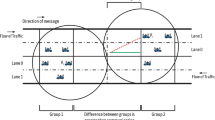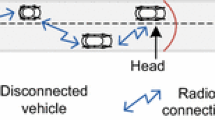Abstract
Mobility models of nodes have an important role in the evaluation of data dissemination protocols in vehicular ad hoc networks (VANETs). Many recent researches have used the constant velocity mobility models while vehicles have acceleration and their speeds change as they move. Because of the dynamic nature of VANETs, the network changes from a densely connected to the sparsely connected environment in a short time. In sparsely connected networks, it is said that vehicles move in clusters. In this paper, the constant acceleration mobility calculations for the sparsely connected network and its characteristics have been presented. These characteristics are usable for the evaluation of the data dissemination protocols in VANETs. The results show that acceleration affects the number of viewed clusters during the trip and the number of vehicles within a cluster. In fact, acceleration has a significant impact on the network sparsely connection. This matter shows that the appropriate data dissemination protocol should be used to study the acceleration effect which is applicable in sparse networks. The analysis in this research provides the necessary background for better understanding and accurate calculations for the evaluation of data dissemination in VANETs.







Similar content being viewed by others
Explore related subjects
Discover the latest articles, news and stories from top researchers in related subjects.Abbreviations
- VANET:
-
Vehicular ad hoc network
- RSU:
-
Road side unit
- DDRC:
-
Data dissemination using rateless codes
- RWP:
-
Random way point
- RPGM:
-
Reference point group mobility model
- SCF:
-
Store-carry-forward
- VADD:
-
Vehicle assisted data delivery
- SODAD:
-
Segment-oriented data abstraction and dissemination
- MDDV:
-
Mobility-centric data dissemination algorithm for vehicular networks
- DP:
-
Data pouring
- GHR:
-
Gazis, Herman and Rothery
- DD:
-
Decoding distance
- NS2:
-
Network simulator
- SUMO:
-
Simulation of urban mobility
References
Davis, J. A., Fagg, A. H., & Levine, B. N. (2001). Wearable computers as packet transport mechanisms in highly-partitioned ad-hoc networks. In Proceedings of the 5th international symposium on wearable computers (ISWC 2001) (pp. 141–148).
Wischhof, L., Ebner, A., & Rohling, H. (2005). Information dissemination in self-organizing intervehicle networks. IEEE Transactions on Intelligent Transportation Systems, 6(1), 90–101.
Wisitpongphan, A. N., Bai, F., Mudalige, P., Sadekar, V., & Tonguz, O. (2007). Routing in sparse vehicular ad hoc wireless networks. IEEE Journal on Selected Areas in Communications, 26, 1538–1556.
Luby, M. (2002). LT codes. In Proceedings of the 34th annual IEEE symposium on foundations of computer science (pp. 271–280).
Wang, Y., Jain, S., Martonosi, M., & Fall, K. (2005). Erasure-coding based routing for opportunistic networks. In Proceeding of the ACM SIGCOMM workshop on delay-tolerant networking (WDTN ’05) (pp. 229–236).
Sardari, M., Hendessi, F., & Fekri, F. (2010). DDRC: Data dissemination in vehicular networks using rateless codes. Journal of Information Science and Engineering, 26, 867–881.
Johnson, D. B., & Maltz, A. (1996). Dynamic source routing in ad hoc wireless networks. In T. Imielinski & H. Korth (Eds.), Mobile Computing (ch. 5, pp. 153-181). Kluwer Academic Press.
Camp, T., Boleng, J., & Davies, V. (2002). A survey of mobility models for ad hoc network research. Wireless Communications and Mobile Computing, 2(5), 483–502.
Boudec, J. L., & Vonjovi, M. (2004). Perfect simulation and stationary of a class of mobility models. In Proceeding of IEEE INFOCOM.
Bai, F., Sadagopan, N., & Helmy, A. (2003). The IMPORTANT framework for analyzing the impact of mobility on performance of routing protocols for ad hoc networks. AdHoc Networks Journal, 1, 383–403.
Hong, X., Kwon, T., Gerla, M., Gu, D., & Pei, G. (2001). A mobility framework for ad hoc wireless networks. In ACM 2nd international conference on mobile data management (MDM).
Tugcu, T., & Ersoy, C. (2004). How a new realistic mobility model can affect the relative performance of a mobile networking scheme. Wireless Communications and Mobile Computing, 4, 383–394.
Xu, K., Zhou, B., & Gerla, M. (2004). Group and swarm mobility models for ad hoc network scenarios using virtual tracks. In IEEE MILCOM.
Namboodiri, V., Agarwal, M., & Gao, L. (2004). A study on the feasibility of mobile gateways for vehicular ad-hoc networks. In Proceedings of the 1st ACM international workshop on vehicular ad hoc networks (VANET ’04) (pp. 66–75).
Zhao, J., & Cao, G. (2006). VADD: Vehicle-assisted data delivery in vehicular ad hoc networks. In Proceedings of the 25th IEEE international conference on computer communications (INFOCOM ’06).
Wu, H., Fujimoto, R., Guensler, R., & Hunter, M. (2004). MDDV: A mobility-centric data dissemination algorithm for vehicular networks. In Proceedings of the 1st ACM international workshop on vehicular ad hoc networks (VANET ’04) (pp. 47–56).
Chen, Z. D., Kung, H. T., & Vlah, D. (2001). Ad hoc relay wireless networks over moving vehicles on highways. In Proceedings of the ACM international symposium on mobile ad hoc networking and computing (MobiHoc ’01) (pp. 247–250).
Johnson, M., Nardis, L. D., & Ramchandran, K. (2006). Collaborative content distribution for vehicular ad hoc networks. In Proceedings of Allerton conference on communication, control, and computing.
Zhao, J., Zhang, Y., & Cao, G. (2007). Data pouring and buffering on the road: A new data dissemination paradigm for vehicular ad hoc networks. IEEE Transactions on Vehicular Technology, 56, 3266–3277.
Park, J., Lee, U., Oh, S., Gerla, M., & Lun, D. (2006). Emergency related video streaming in vanet using network coding. In Proceedings of ACM VANET (pp. 102–103).
Cataldi, P., Tomatis, A., Grilli, G., & Gerla, M. (2009). CORP: Cooperative rateless code protocol for vehicular content dissemination. In Proceeding of IFIPIEEE Med-Hoc-Net.
Budde, R., Nowak, S., & Kays, R. (2011). Reliable distribution of electronic media in vehicular networks based on fountain codes. In 14th ITG conference on electronic media technology (CEMT) (pp. 23–24).
Hartenstein, H., & Laberteaux, K. P. (2010). VANET: Vehicular Applications and Inter-Networking Technologies. New York: Wiley.
Fiore, M. (2006). Mobility models in inter-vehicle communications literature. Technical Report
Gazis, D. C., Herman, R., & Rothery, R. W. (1961). Nonlinear follow the-leader models of traffic flow. Operations Research, 9(4), 545–567.
Panwai, S., & Dia, H. (2005). Comparative evaluation of microscopic car-following behavior. IEEE Transactions on Intelligent Transportation Systems, 6(3), 314–325.
Arbabi, H. (2011). Monitoring free flow traffic using vehicular networks. In IEEE consumer communications and networking conference (CCNC).
Yousefi, S., Altman, E., Elazouzi, R., & Fathy, M. (2008). Improving connectivity in vehicular ad hoc networks: An analytical study. Computer Communications, 31, 1653–1659.
Miorandi, D., & Altman, E. (2006). Connectivity in one-dimensional ad hoc networks: A queuing theoretical approach. Wireless Netorks, 12(6), 573–587.
Sou, S. I., & Tonguz, O. K. (2011). Enhancing VANET connectivity through roadside units on highways. IEEE Transactions on Vehicular Technology, 60(8), 3586–3602.
Abboud, K., & Zhuang, W. (2009). Modeling and analysis for emergency messaging delay in vehicular ad hoc networks. In Proceeding IEEE Globecom’09 (pp. 1–6).
Khabazian, M., Mehmet-Ali, M., & Aissa, S. (2013). Analysis of continuous communication availability in vehicular ad hoc networks. IEEE Systems Journal, 7(1), 137–150.
Haight, F. A. (1963). Mathematical theories of traffic flow. New York: Academic Press.
Garber, N. J., & Hoel, L. A. (2009). Traffic and highway engineering. Canada: Congage Learning.
Roess, R. P., Prassas, E. S., & Mcshane, W. R. (2004). Traffic engineering. New Jersey: Pearson Academic Inc., Prentice Hall.
Author information
Authors and Affiliations
Corresponding author
Rights and permissions
About this article
Cite this article
Khiadani, N.H., Hemami, S.M.S. & Hendessi, F. Analysis of Acceleration Effect in Data Dissemination in Vehicular Networks Using Rateless Codes. Wireless Pers Commun 77, 991–1006 (2014). https://doi.org/10.1007/s11277-013-1548-3
Published:
Issue Date:
DOI: https://doi.org/10.1007/s11277-013-1548-3




